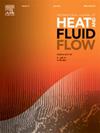Al2O3-TiO2/水混合纳米流体的传热优化:半分析方法
IF 2.6
3区 工程技术
Q2 ENGINEERING, MECHANICAL
International Journal of Heat and Fluid Flow
Pub Date : 2025-07-19
DOI:10.1016/j.ijheatfluidflow.2025.109976
引用次数: 0
摘要
本文探讨了Al2O3-TiO2/水混合纳米流体在收敛/发散通道内的流动和传热,并进行了不可逆性分析。所采取的假设是热源/汇、辐射、粘性耗散、速度和热滑移效应。纳米颗粒形状和纳米颗粒混合比例也被考虑在内。利用相似变换将控制偏微分方程转化为常微分方程,利用Adomian分解技术求解。随着速度滑移的增加,收敛通道和发散通道的速度剖面增大,而温度和熵产剖面减小。温度和熵的产生随着热滑移而增加。圆柱形和砖形纳米颗粒的传热和熵产比球形纳米颗粒高。与其他比例相比,Al2O3(10%)-TiO2(90%)/H2O混合物具有更好的传热性能。使用多元线性回归的附加分析突出了各种参数对传热率和表面摩擦的影响。在发散通道中,雷诺数和速度滑移对表面摩擦力有正向影响,而在收敛通道中,雷诺数有负向影响,速度滑移有正向影响。在两个通道中,Eckert数、热滑移和热源参数对Nusselt数有正向影响,而速度滑移参数对Nusselt数有负向影响。具体来说,5%纳米颗粒悬浮液在水中的传热率在发散通道中分别提高了3.61%、32.23%和109.67%,在收敛通道中,球形、砖形和圆柱形纳米颗粒的传热率分别提高了3.57%、30.45%和104.60%。本文章由计算机程序翻译,如有差异,请以英文原文为准。
Optimization of heat transfer in Al2O3-TiO2/water hybrid nanofluids: A semi-analytical approach
This paper explores the AlO-TiO/water hybrid nanofluid flow and heat transfer within a convergent/ divergent channel along with irreversibility analysis. The assumptions taken are the heat source/sink, radiation, viscous dissipation, velocity, and thermal slip effects. The nanoparticle shapes and nanoparticle mixture ratios are also taken into account. Similarity transformations are used to convert the governing partial differential equations into ordinary differential equations, which are solved using the Adomian decomposition technique. As velocity slip increased, velocity profiles increased, while temperature and entropy generation profiles decreased in both the convergent and divergent channels. Temperature and entropy generation increased with thermal slip. Cylindrical and brick-shaped nanoparticles yielded higher heat transfer and entropy generation than spherical shapes. The AlO(10%)-TiO(90%)/HO mixture provided superior heat transfer compared to other ratios. Additional analysis using multiple linear regression highlights the influence of various parameters on heat transfer rates and skin friction. In divergent channels, Reynolds number and velocity slip positively affected skin friction, while in convergent channels, Reynolds number had a negative impact and velocity slip had a positive effect. The Eckert number, thermal slip, and heat source parameters positively influenced, whereas the velocity slip parameter negatively influenced, the Nusselt number in both channels. Specifically, the heat transfer rates for a 5% nanoparticle suspension in water improve by 3.61%, 32.23%, and 109.67% in the divergent channel and 3.57%, 30.45%, and 104.60% in the convergent channel for spherical, brick, and cylindrical-shaped nanoparticles, respectively.
求助全文
通过发布文献求助,成功后即可免费获取论文全文。
去求助
来源期刊

International Journal of Heat and Fluid Flow
工程技术-工程:机械
CiteScore
5.00
自引率
7.70%
发文量
131
审稿时长
33 days
期刊介绍:
The International Journal of Heat and Fluid Flow welcomes high-quality original contributions on experimental, computational, and physical aspects of convective heat transfer and fluid dynamics relevant to engineering or the environment, including multiphase and microscale flows.
Papers reporting the application of these disciplines to design and development, with emphasis on new technological fields, are also welcomed. Some of these new fields include microscale electronic and mechanical systems; medical and biological systems; and thermal and flow control in both the internal and external environment.
 求助内容:
求助内容: 应助结果提醒方式:
应助结果提醒方式:


